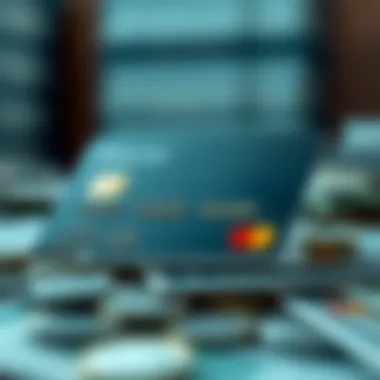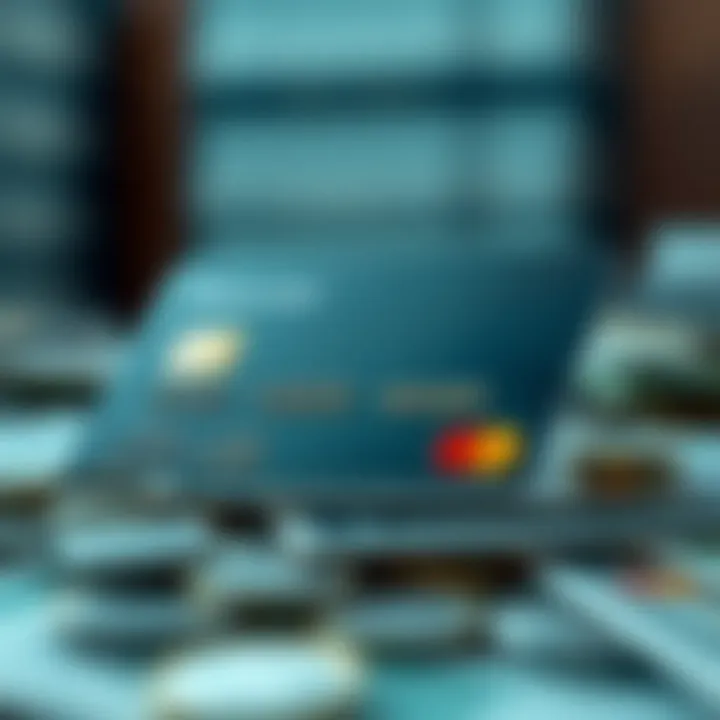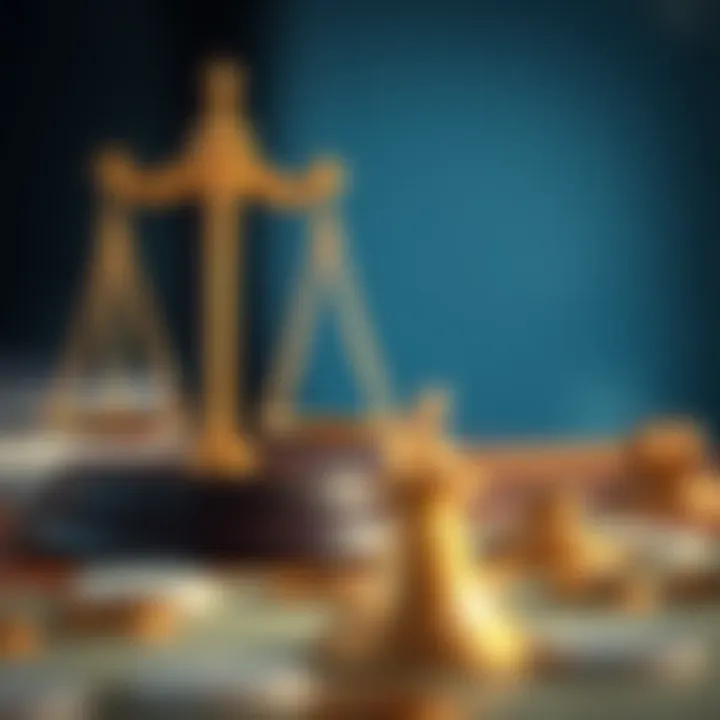Understanding Bankruptcy in Relation to Credit Card Debt


Intro
Navigating the thorny waters of bankruptcy and credit card debt can be quite the daunting task. For many, it's a topic shrouded in confusion and anxiety, often viewed through the lens of stigma. However, understanding this landscape is crucial for making sound financial decisions. With the increasing reliance on credit cards in today’s economy, many individuals find themselves stranded in a sea of debt, unsure of how to proceed when the burden becomes overwhelming. This article aims to provide clarity on the intersections of these two formidable aspects of personal finance.
Declaring bankruptcy can feel like a final resort, almost like waving a white flag in the battle against debt. Yet, being informed about the various paths to take can empower individuals to regain control over their financial situation. Factors such as the implications of credit card usage, the stages leading to bankruptcy, and viable alternatives are critical to explore. Education on these matters is not just beneficial; it’s essential for anyone grappling with credit card debt.
In the following sections, we’ll dissect key terms and concepts, explore the legal processes, and discuss the ramifications of these choices. By providing practical insights and expert advice, this article seeks to equip readers with the necessary tools to tackle their financial challenges head-on.
Understanding Bankruptcy
Navigating the financial waters can be a treacherous journey, and understanding bankruptcy is akin to having a life raft during a storm. This section will delve into the core concept of bankruptcy, its purpose, and various types, all crucial topics for anyone encountering the realities of financial distress. Gaining a clear comprehension of bankruptcy can help individuals and businesses alike make informed decisions when faced with overwhelming debts, particularly credit card liabilities that can balloon out of control.
Knowing the ins and outs of bankruptcy not only demystifies a process often viewed with stigma but also presents a framework for recovery and financial rejuvenation. Whether one's goal is to wipe the slate clean or to figure out a viable path forward, understanding bankruptcy is pivotal.
Definition of Bankruptcy
Bankruptcy, in simple terms, is a legal process that allows individuals or entities unable to repays debts to seek relief from some or all of their liabilities. It’s a form of protection provided by federal law, designed to assist those in financial difficulty to get a fresh start. However, it’s not just a free pass—it involves serious implications for one’s credit score and financial future.
Purpose of Bankruptcy
The primary purpose of bankruptcy is to provide a structured way to manage and eliminate debts while ensuring fair treatment for creditors. By filing for bankruptcy, individuals can gain immediate relief from creditors, stop collection activities, and potentially discharge certain debts altogether. It's essential to recognize that the aim is not just to escape debts but to set the stage for a better financial foundation moving forward. Bankruptcy serves both the debtor's need for relief and the creditor’s interest in recovering owed money, creating a balance that's crucial for a properly functioning economy.
Types of Bankruptcy
When it comes to bankruptcy, there are key forms that individuals or businesses can explore. Each type has its unique properties and implications.
Chapter Seven
Chapter Seven, often referred to as "liquidation bankruptcy," is popular due to its relatively straightforward process. This approach allows people to discharge unsecured debts, which includes many credit card debts, without having to repay them. The defining feature of Chapter Seven is that a trustee is assigned to liquidate non-exempt assets, using the proceeds to pay off creditors. This can be a beneficial option for individuals who have few if any assets of value. One unique aspect is the ability to have certain personal property exempt from liquidation, thus enabling individuals to retain essential items like vehicles or household goods. However, it doesn't clear all types of debt; for instance, obligations like child support and certain tax debts are generally not dischargeable in this process.
Chapter Thirteen
On the other hand, Chapter Thirteen is often known as a “reorganization bankruptcy,” aimed at individuals with a regular income who wish to keep their assets while paying off debts over time. This type usually involves the development of a repayment plan which must be approved by the court. A significant feature of Chapter Thirteen is that it allows debtors to catch up on missed mortgage payments and avoid foreclosure of their home. While it often involves making monthly payments over three to five years, it provides a structured method for individuals to regain control over their finances without losing their property. The downside might be the length of the repayment process, which can be daunting for many.
Chapter Eleven
Primarily utilized by corporations and businesses, Chapter Eleven bankruptcy involves a reorganization of a debtor's financial affairs. This type is complex and is often seen as a last resort for companies facing severe financial distress. Businesses remain in control of their operations while proposing a plan to restructure debts. It's valuable for large corporations seeking to salvage their enterprises by negotiating with creditors, staff, and investors, essentially finding a way to keep their doors open while they reorganize their finances. However, not all reorganization efforts are successful, and the process can be lengthy and costly, potentially leading to a further breakdown rather than recovery.
Understanding these elements lays a solid groundwork for exploring the subsequent topics regarding credit card debt and its intricate ties to bankruptcy. Thus, it sets the stage for informed discussions about navigating these muddy financial waters.
Credit Card Debt Explained
Understanding credit card debt is crucial, especially when economic challenges arise. Many people find themselves entangled in this kind of debt due to easy access to credit, which can feel like a safety net but often leads to financial peril. Better grasping this topic can illuminate options for debt management and empower individuals to make informed financial decisions.
What Constitutes Credit Card Debt
Credit card debt stems from the use of credit cards for purchases. When a consumer buys goods or services on credit, they are essentially borrowing money from their credit card issuer, expecting to pay it back within a certain timeframe. Key aspects of credit card debt include:
- Principal Amount: This is the actual amount spent on the card.
- Interest Charges: If not paid in full by the due date, the outstanding balance accumulates interest, which can compound quickly.
- Fees: These may include annual fees, late payment penalties, or over-limit charges, which can further inflate the total debt.
- Minimum Payments: Credit card companies often allow low minimum payments, which can trap consumers in a cycle of debt, as paying only the minimum prolongs repayments and increases interest accrued.
Impacts of Accumulating Debt
Accumulating credit card debt can have serious ramifications. Here are some realizations that often take people by surprise:
- Credit Score Decline: High levels of credit utilization can severely impact credit scores, leading to higher interest rates for future borrowing.
- Stress and Anxiety: Financial pressure can lead to emotional distress, affecting relationships and overall quality of life.
- Potential for Bankruptcy: If the debt spirals out of control, bankruptcy might become the only recourse, which can have long-lasting effects on financial standing.
"The lure of credit cards is as tempting as a siren's call, but the rocky shore they lead to can be devastating if not navigated carefully."
Common Causes of Credit Card Debt
Several factors contribute to the accumulation of credit card debt, each reflecting unique behavioral and situational elements:


- Lifestyle Inflation: As incomes rise, people often feel compelled to upgrade their living standards, leading to increased spending.
- Poor Financial Planning: Without a budget, it's easy to stray into unnecessary purchases, relying too heavily on credit.
- Unexpected Expenses: Medical bills, car repairs, or job loss can turn credit cards into a lifeline, albeit one that leads to a deeper financial hole.
- Consumer Culture: The societal pressure to have the latest gadgets or fashion can prompt excessive use of credit, without considering the long-term implications on finances.
By recognizing what credit card debt is, why it accumulates, and its significant impacts, individuals can better navigate their financial situations and make choices that lead to healthier financial habits in the long run.
The Intersection of Bankruptcy and Credit Card Debt
Understanding the crossroads between bankruptcy and credit card debt is crucial for not just those facing fiscal hardship, but for financial professionals, investors, and analysts as well. A firm grasp of how these two elements interact reveals much about consumer behavior, market trends, and even economic health. For individuals overwhelmed by debt, pinpointing when to declare bankruptcy can save them from deeper financial turmoil. For financial advisors and brokers, recognizing the patterns in such cases can enhance their guidance and strategies for clients in peril.
When to Consider Bankruptcy for Credit Card Debt
Determining the right moment to contemplate bankruptcy regarding credit card debt isn't a cut-and-dry decision. Various factors converge, making it essential to evaluate one's financial situation thoroughly. Here are some indicators:
- Persistent Late Payments: If you find yourself consistently missing payments or only making minimum contributions on credit cards, this is a red flag. Over time, accumulating late fees can result in a spiraling debt situation that seems insurmountable.
- Excessive Interest Rates: Credit cards can come with sky-high interest rates, making it difficult to chip away at the principal balance. If the interest you are paying is significantly stunting your ability to pay down debt, bankruptcy may warrant consideration.
- Collection Calls and Legal Actions: When you begin receiving calls from creditors or face potential lawsuits, it's a strong indication that the issue has escalated. This might be the moment to consult legal advice concerning bankruptcy.
- Living Expenses vs. Debt: Take time to tally up your monthly obligations. If essential expenses surpass your income and allow little to no room for debt repayment, that is a significant moment for reflection.
Recognizing these signs can pave the way for a more informed decision-making process.
How Bankruptcy Affects Credit Card Debt
Once a bankruptcy petition is filed, the impact on credit card debt can be profound.
- Automatic Stay: Upon filing for bankruptcy, an automatic stay kicks in. This legal protection halts creditors from trying to collect debts, giving individuals respite from relentless creditor pressure. It's like hitting the pause button on an overwhelming situation. However, this doesn’t erase the debt; it merely suspends collection efforts temporarily.
- Discharge of Debt: Depending on the type of bankruptcy you file—Chapter 7 or Chapter 13—certain credit card debts may be discharged altogether. In the case of Chapter 7, most unsecured debts, like these, can be wiped clean. This can give a fresh start to individuals who burdened themselves under the weight of unmanageable credit card balances.
- Impact on Credit Score: Declaring bankruptcy isn’t a free pass. It severely affects one’s credit score. A bankruptcy filing astride a storm of credit card debt can decrease a score by hundreds of points, making future borrowing more difficult. This impacts not just credit card applications but other aspects of financial life, including mortgages and car loans.
- New Credit Accounts: After declaring bankruptcy, accessing new credit becomes a challenge. Creditors might view individuals with recent bankruptcy filings as high-risk, which can restrict financial flexibility down the road.
Navigating the waters of credit card debt and bankruptcy is complex. The implications of filing for bankruptcy often ebb and flow, impacting an individual's future financial landscape in ways that may not be immediately apparent. For those immersed in the field of finance, understanding these nuances is imperative for sound advice and strategy in ensuring clients maintain a healthy financial slate.
The Bankruptcy Process
Filing for bankruptcy is not merely a legal formality. It’s a significant step that impacts one's financial future in many ways. Understanding the bankruptcy process is crucial for anyone contemplating this path, particularly as it interlinks closely with credit card debt. The process requires careful navigation through the legislative waters, and comprehending its elements can help demystify much of the stress associated with it. Here, we delve into some key parts of the bankruptcy process that shed light on its workings, benefits, and considerations.
Filing for Bankruptcy
The journey begins when an individual realizes that debts have spiraled beyond manageable limits. The act of filing for bankruptcy necessitates the completion of several forms and the gathering of necessary documentation. This documentation typically includes assets, liabilities, income, and expenses. It's a process that can feel overwhelming; however, this meticulous dissection of financial standing is essential.
Filing for bankruptcy can lead to various outcomes, depending on the chapter one files under – be it Chapter Seven or Chapter Thirteen, for instance.
Key Points to Consider:
- Eligibility Requirements: Before one dives into the process, understanding eligibility criteria based on income level is vital. The means test ensures that only individuals who truly need relief can proceed.
- Credit Counseling: Most jurisdictions mandate credit counseling to be taken before filing. This step aims to educate debtors about financial management and potential alternatives to bankruptcy.
Once the initial steps are complete, the hope is to achieve a fresh start. For many, this represents an opportunity to clean the slate, but it’s also vital to recognize the stigma attached to bankruptcy. Nevertheless, it can be a turning point, paving the way for financial rehabilitation.
The Role of the Bankruptcy Trustee
Central to the bankruptcy process is the role of the bankruptcy trustee. This person acts as the overseer of the bankruptcy case, ensuring that the process is handled lawfully and fairly. The responsibilities are multifaceted and crucial for an effective liquidation or reorganization of debts.
Responsibilities of the Bankruptcy Trustee:
- Reviewing Documentation: The trustee examines the paperwork submitted by the debtor for accuracy and completeness. Mistakes can complicate the process, so attention to detail is vital.
- Meeting of Creditors: A meeting where creditors can ask questions about the debtor's financial affairs. This meeting, often known as the 341 hearing, provides insight into the debtor's sincerity and financial situation.
- Distributing Assets: If filing under Chapter Seven, the trustee evaluates the debtor’s non-exempt assets and liquidates these to pay off creditors. In cases of Chapter Thirteen, the trustee administers the repayment plan set forth.
This role might seem daunting, but it's a necessary part of the system that helps maintain fairness among all parties involved. The trustee's decisions can influence the outcome of the bankruptcy, making their role pivotal.
How Long Does the Process Take?
One burning question for those navigating bankruptcy is: how long will it take? The timeline can vary based on a number of factors, including the complexity of one's financial situation and the type of bankruptcy filed.
General Timelines:
- Chapter Seven Bankruptcy: Often completed in about three to six months. This swift resolution is partly due to the straightforward nature of liquidating assets.
- Chapter Thirteen Bankruptcy: Typically extends over three to five years, as this type involves a repayment plan that is negotiated and structured over time.
- U.S. Courts - Bankruptcy Basics
- Nolo - Bankruptcy and Debt
To summarize, knowledge is a powerful tool in navigating the intricate landscape of bankruptcy and figuring out the path that best suits one's financial needs.
Considerations Before Declaring Bankruptcy
Bankruptcy is a heavy word, often accompanied by a barrage of emotions and hard decisions. It’s vital to take a step back and evaluate not only your financial standing but also the broader implications of such a significant choice. This section underscores the importance of thoughtful consideration prior to committing to bankruptcy. There are specific elements that can impact one’s financial future significantly, and understanding these elements can pave the way to making informed decisions.


Assessing Your Financial Situation
Before jumping into the bankruptcy arena, scrutinizing your financial health is non-negotiable. Begin with a deep dive into your income, expenses, assets, and liabilities. This assessment is not merely about having a snapshot of your finances but rather understanding the entirety of your financial landscape.
- Income Overview: Make a detailed inventory of all sources of income. Is it stable? Are there varying factors that could influence your earnings? Having a clear picture helps in evaluating how much debt you could feasibly handle.
- Monthly Expenses: Create a spreadsheet to list all monthly expenses. Be thorough – include essentials like rent and utilities, but also variable expenses such as dining out or subscription services. This shows your spending habits and pinpoints areas for potential cuts.
- Debt Obligations: Catalog all debts, noting the interest rates and payment dates. Prioritize which debts need immediate attention and identify which can be negotiated or deferred.
- Assets: Look at what you own. A vehicle, home, investments – these assets could either provide leverage in negotiations with creditors or play a hard role if heading towards bankruptcy.
Understanding your financial position enables a clearer evaluation of whether bankruptcy is genuinely the best step. While it may seem like an easy out, it tends to bring about long-lasting consequences on credit and financial freedom. That brings us to the next consideration.
Consulting With a Financial Advisor
Seeking professional guidance can often save you from the brink of financial disaster. A financial advisor can offer insights that you may not have considered yourself. Here’s how a financial advisor can help:
- Objective Perspective: Sometimes, it takes a third party to see beyond the numbers. An advisor can provide an unbiased opinion on whether bankruptcy is the best route given your circumstances.
- Financial Planning: They can help strategize on how to manage debts without declaring bankruptcy. This becomes essential when addressing work-related payouts and planning for future expenses.
- Long-Term Goals: Advisors can help set realistic financial goals following either a bankruptcy declaration or debt repayment plan. Understanding your financial future post-bankruptcy is crucial to ensure you don’t stumble into the same pitfalls later.
- Alternatives: Getting expert feedback could unveil other viable alternatives to bankruptcy, like debt management plans or debt settlement opportunities.
"Bankruptcy should not be viewed just as a pain point, but as a unique juncture at which many paths can emerge. Bring in an expert to help guide those paths."
In closing, careful consideration prior to declaring bankruptcy cannot be overstated. Assess your financial situation and consider the value of professional counsel before making a decision. Keeping these factors in mind can not only help you navigate bankruptcy better but also empower your financial future.
Alternatives to Bankruptcy
Considering alternatives to bankruptcy can be a game changer for many individuals facing financial distress. This section provides a closer look at options that can help manage debt without completely utilizing the bankruptcy route. Bankruptcy, while a viable option under certain circumstances, may carry long-lasting implications on an individual’s credit score and financial standing. Therefore, exploring alternatives often serves as a progressive step toward reclaiming financial stability.
Debt Consolidation
Debt consolidation is often perceived as one of the more favorable alternatives to bankruptcy. This option involves combining multiple debts into a single loan, ideally at a lower interest rate. By doing this, individuals can simplify their monthly payments and potentially reduce total interest payments over time. Here are some points to consider:
- Lower Interest Rates: Consolidation loans often come with lower rates, especially for secured loans. This can lead to substantial savings in interest charges.
- Simplicity: Managing one loan instead of several can lead to less stress and easier budgeting.
- Payment Schedule: Many options allow for personalized repayment terms that match one’s financial scenario.
However, a couple of caveats should be kept in mind. First, it may require collateral to secure the loan, which increases the risk of loss. Second, without addressing underlying spending habits, individuals might find themselves in the same predicament shortly after consolidating their debts.
Negotiating With Creditors
Another effective strategy is negotiating directly with creditors. Many lenders are open to discussions, especially when they see the possibility of receiving some payment rather than none. Here’s how to approach this:
- Propose a Settlement: It’s possible to negotiate a lower total owed by proposing a lump-sum payment that might be less than the full amount. Creditors often prefer receiving a share of what’s owed rather than risking potential bankruptcy.
- Request Lower Interest Rates: Sometimes, a simple phone call can lead to lower rates which can make a significant difference in monthly payments.
- Tell Your Story: Sharing personal circumstances related to financial hardship can create empathy, and sometimes creditors are willing to work with individuals facing genuine difficulties.
Though negotiation may initially seem daunting, it can often provide individuals with a tailored approach based on their specific financial situation.
Credit Counseling Services
Using credit counseling services is another sound alternative. These services can offer guidance, help develop feasible budgets, and may even negotiate on behalf of the consumer. Here are key elements about credit counseling:
- Professional Guidance: Skilled counselors can help individuals identify the root cause of their debt and create a realistic repayment plan.
- Debt Management Plan: Through a credit counseling agency, individuals can set up a debt management plan (DMP) that consolidates debt payments into one monthly payment, often at reduced interest rates.
- Financial Education: These services typically offer educational resources which can empower consumers with the knowledge needed to manage finances better in the future.
In a world where overspending is a prominent concern, addressing debt with the aid of specialists can be more effective than tackling it alone.
"The best way to get out of debt isn’t to go into bankruptcy; it’s to figure out what got you there in the first place and change your habits."
In summary, while bankruptcy might seem like the only escape from crippling debt, a variety of alternatives exist that can not only help mitigate financial distress but also pave the way for a thorough understanding of financial habits and responsibility.
Post-Bankruptcy Life
Navigating the aftermath of bankruptcy can feel like climbing a mountain without gear. The view from the top might be clearer, but the trail isn't always easy. Life post-bankruptcy often entails rebuilding not just finances but also the sense of security that comes with healthy financial habits. Understanding what comes next can help individuals regain their footing and prevent past mistakes from becoming reruns in the future.
Rebuilding Your Credit Score
One of the critical facets of post-bankruptcy life is the challenge of rebuilding your credit score. After bankruptcy, your credit report may seem like a mountain of red flags. However, it’s essential to know that these things can and do improve over time. Here are a few steps to consider:
- Open a secured credit card: This card requires a cash deposit that acts as your credit limit. Use it for small purchases and pay it off each month to gradually build your credit.
- Pay bills on time: Future lenders are not only looking at your credit cards but also how you manage everyday expenses. Late payments can drag your score down further.
- Monitor your credit report: Regular checks can help you track progress and identify errors that could harm your score. Services like AnnualCreditReport.com can offer insight into your credit standing.
"Your credit score is not just a number; it’s a reflection of your financial behavior and future reliability."


Financial Habits After Bankruptcy
After declaring bankruptcy, reassessing financial habits is crucial. You want to reduce the risk of finding yourself in murky waters again. Some practical habits to establish include:
- Create a budget: Keep track of income and expenses. Understanding exactly where your money goes can help in making informed decisions.
- Establish an emergency fund: Life is unpredictable. Having a safety net can prevent you from sliding back into debt during tough times.
- Educate yourself: Familiarize yourself with personal finance concepts, such as interest rates, loans, and investments. Knowledge can help safeguard against poor financial decisions.
Future Financial Planning
Preparing for the future involves more than just paying off debt. It's about building a solid foundation for financial independence. Here are factors to contemplate:
- Setting life goals: Whether it’s buying a house, investing for retirement, or saving for education, having clear goals can provide direction.
- Consider long-term investments: Once stable, look into investing options like stocks, bonds, or mutual funds. Though there are risks, long-term investing can yield substantial rewards.
- Consult a financial advisor: If necessary, seeking guidance from a professional can further refine your approach and ensure you’re not missing out on opportunities.
By understanding the landscape of post-bankruptcy life, individuals can embrace their financial future with both caution and optimism. The road ahead may not be straightforward, but with the right tools and mindset, it can lead you to solid ground.
Legal Implications of Bankruptcy
Understanding the legal implications of bankruptcy is crucial for individuals and businesses contemplating this path. The decision to declare bankruptcy isn't merely a financial maneuver; it's a legal one, carrying significant ramifications. When one files for bankruptcy, they step into a complex legal landscape that requires a comprehensive understanding of rights, responsibilities, and consequences.
Understanding Exemptions
One of the most notable aspects of bankruptcy law is the concept of exemptions. Exemptions allow debtors to protect certain assets from being liquidated to pay creditors. This aspect is particularly important for individuals, as it can mean the difference between losing essential belongings and retaining them.
Typically, exemptions vary from state to state, governed by both federal and local laws. Generally, common exemptions include:
- Primary residence: Under the homestead exemption, homeowners can often retain their home, up to a certain equity limit.
- Personal property: Debtors may retain basic household items, such as clothing and furniture, which are deemed necessary for daily living.
- Retirement accounts: Funds in retirement accounts, like 401(k)s and IRAs, may also be protected from creditors.
It’s essential to consult a legal expert to understand which assets might qualify for exemption in your jurisdiction, as state laws play a significant role in this process.
Navigating these exemptions can empower debtors to emerge from bankruptcy with a semblance of financial stability. It also provides a vital cushion during the transition, preventing individuals from starting over entirely devoid of means.
Potential Consequences of Bankruptcy
While bankruptcy can often provide a fresh financial start, it also bears several potential consequences that one must consider.
First and foremost is the impact on one’s credit report. A bankruptcy filing remains visible on a credit report for seven to ten years, depending on the type of bankruptcy, creating a shadow that can affect future borrowing and interest rates.
In addition, individuals may face:
- Increased scrutiny in future debt applications: Lenders might be more cautious when considering applications from individuals with a recent bankruptcy.
- Potential loss of secured assets: While exemptions apply, not all assets may be safe, particularly secured debts like mortgages or auto loans.
- Emotional and social implications: The stigma surrounding bankruptcy can lead to feelings of shame or failure, impacting one’s mental well-being and relationships.
Ultimately, understanding these consequences is key to making informed choices about whether to pursue bankruptcy. With proper knowledge and guidance, individuals can navigate their circumstances wisely, weighing both the immediate relief and the long-term effects on their financial health.
For further reading on bankruptcy laws and regulations, visit nolo.com or consumerfinance.gov.
In summary, delving into the legal implications of bankruptcy not only equips individuals with the knowledge necessary to make sound decisions but also underscores the intricacies of this significant financial step. Ensuring informed choices can alter one’s financial trajectory for the better, serving as a pivotal moment in reclaiming stability.
Culmination
Reflecting on the landscape of bankruptcy and credit card debt, it becomes clear that understanding this complex interplay is crucial for anyone navigating financial challenges. This article has explored various facets of bankruptcy and its implications on credit card debt, providing a thorough guide to aid in making informed decisions. The considerations for declaring bankruptcy aren’t just about legality; they also involve personal introspection and financial strategy.
Reflecting on the Decision
When considering bankruptcy, it is paramount to reflect critically on one’s situation. This isn't merely a legal process; it's a life-altering decision that requires deep thought. Taking a moment to assess your current financial state and future goals can save you from a lot of potential heartache. Many people find themselves caught in a web of emotions, ranging from embarrassment to fear of stigma. But, it’s essential to remember this: every financial situation differs, and bankruptcy is an option for a reason. Look at your unique circumstances—are you facing insurmountable debt solely from mismanagement, or are there external factors, such as medical emergencies or job loss, that have placed you in this position? Think about your long-term goals and how bankruptcy might affect them. Would it release you from the shackles of relentless creditor calls or allow you to start fresh?
In this process of reflection, it may also benefit you to speak with financial advisors who could provide pragmatic insights. They can help debunk myths surrounding bankruptcy and offer alternative strategies too. However, realize that the choice rests solely with you, weighing the pros and cons carefully before pulling the trigger.
Long-Term Views on Financial Management
The journey doesn’t end with the bankruptcy declaration, nor should it. It marks the beginning of necessary changes in your financial habits. Establishing effective long-term financial management is a critical aspect often overlooked. This requires discipline, patience, and a shift in mindset. After bankruptcy, it may feel like you’re starting from square one—but this time, you have the wisdom of experience to guide you.
Moving forward, focus on building a solid budget that helps you track spending and savings. Prioritizing needs over wants can position you for a brighter financial future. Moreover, consider adopting habits like an emergency savings fund, which serves as a cushion against unexpected expenses. Paying with cash instead of credit could also help rewire your financial habits. The aim here is to create a lifestyle that promotes sustainability and avoids the pitfalls that could lead back to debt.
One should also keep an eye on how to rebuild credit responsibly. While bankruptcy can seem like a significant dent in your financial record, it doesn’t mean your credit life is over. Engage in small, manageable credit-building activities, like secured credit cards or small loans, and pay them off promptly. This not only helps repair your credit score but also instills a sense of fiscal responsibility.
In the grand scheme of things, navigating bankruptcy and credit card debt is about more than just numbers; it’s about learning to manage your finances effectively. Embrace this learning opportunity, and leverage the resources available to you—after all, an informed decision today can lead to a more secure tomorrow.
"Financial freedom is available to those who learn about it and work for it."
Remember, the ultimate goal is to emerge from this experience wiser, stronger, and ready to tackle future challenges with renewed vigor.



